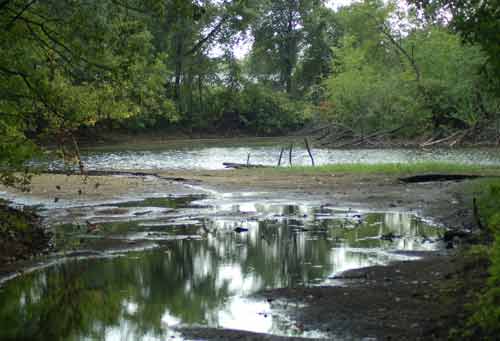http://www.readthebridge.info/2487

Picture: Bridal Veil Pond and Creek last summer, before the MPCA's remediation began.
Six months ago, Bridal Veil Open Space looked like what it was: an overgrown, 6.6-acre wetland surrounded by warehouses in an industrial area near Como’s St. Paul border. What may have been less apparent was the contamination in the pond, creek and topsoil.
Now, thanks to an ongoing $1.25 million face lift, the area — off of Kasota Avenue and Bridal Veil Circle, just north of the Burlington Northern Railroad line — is little more than a giant bowl of snow-crusted earth, where Caterpillars and yellow-vested workers roam behind a chain-link fence.
By June, however, the wetland should be back to a natural state — without the pollution.
The city-owned plot is home to both Bridal Veil Pond (created by the city back in the 1970s as a storm water retention pool) and Bridal Veil Creek, which runs through the property before it goes underground, flowing through a pipeline beneath Prospect Park and eventually into the Mississippi River as Bridal Veil Falls, just upstream from the Franklin Avenue bridge.
Several studies of Bridal Veil Open Space conducted by the Environmental Protection Agency (EPA) and the MPCA indicated that the site was contaminated with PCP, dioxins and other metals. Gary Krueger, who works in the remediation division at the Minnesota Pollution Control Agency (MPCA) said that the MPCA has traced the chemicals back to a now-defunct company called Valentine Clark, which operated immediately northeast of the site.
From 1908 all the way up to 1962, according to the MPCA, Valentine Clark treated wooden telephone poles with creosote and PCP preservative right along the area where Bridal Veil Creek runs. Krueger said the remediation has been planned for several years, to minimize potential risk to the public. (Bridal Veil Open Space is not an officially designated public park but does get human traffic, Krueger said.)
After determining there was no way to go after the obsolete company or anyone still affiliated with it, it was decided that state money would have to be used for the clean up.
Bridal Veil Open Space is a state superfund site, meaning it is a priority site eligible for state funding. Money for the project will come from a state remediation fund, which is partially subsidized by the taxes residents pay on garbage disposal, Krueger said.
After consulting with the city’s public works department and meeting with local neighborhood groups — including the Southeast Como Neighborhood Association (SECIA) — STS Consultants, contracted by the state, devised a specific remediation plan for Bridal Veil Open Space. The project includes:
- Removal of current vegetation to make room for four feet of clean soil over the entire space, creating a “cap” over the area.
- Diverting a section of the creek to underground and creating a waterfall feature where the open creek runs through the wetland
- Creation of a new trail to allow maintenance crews into the area
- Converting the existing pond to a wetland to help to further reduce exposure
- Installation of sediment-collection basins
- Reseeding the area with grasses and other plantings
James DeSota, neighborhood coordinator for SECIA, said the MPCA and STS Consultants did an “excellent job” of incorporating community requests into the project design. Early on, there was talk of sealing off the entire site with a concrete cap, DeSota said. At the request of neighbors, he said, STS made it a point to keep the water feature intact. “It’s been a pretty win-win situation all around,” DeSota said.
Fortunately, the contaminants appear to be isolated to the open space. The MPCA has done studies downstream at Bridal Veil Falls, as well, but so far has not found those same contaminants. Krueger said this could be the result of natural degradation or simply dilution.
The MPCA is mostly concerned with the construction portion of the project. The types of plantings that will be used once the dirt seal is formed, and what kind of other cover material can be brought in, have yet to be finalized, Krueger said.
While early estimates placed the cost of remediation at $3–4 million. Krueger said in a January interview, “it’s going to be a lot less than that.” Six companies submitted proposals for the remediation contract, with bids ranging from $1.25 to $2 million. The overall cost of the project, including the plantings, could be a little over $1.25 million, Krueger said.
“We want to get our base plan in place, so to speak,” Krueger said, adding that the city or SECIA might “take the reigns” to help determine what the site will look like in its final form.
DeSota echoed similar sentiments. “Ideally this spring we’ll get together… once all the heavy lifting is done.” DeSota didn’t know precisely when planning would begin for the reseeding and planting phase of the remediation, but added, “hopefully before June 2008.”
last revised: January 22, 2008